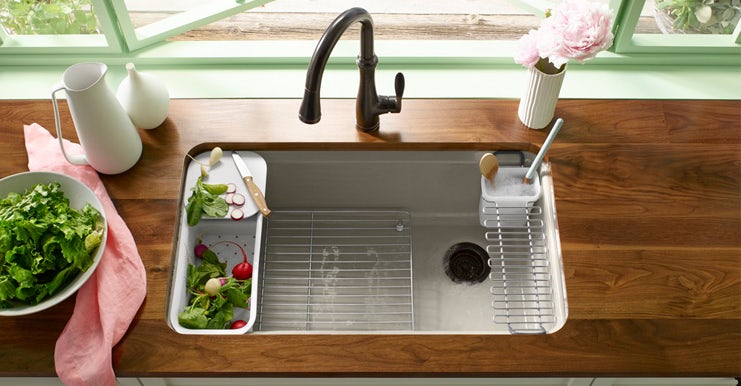Browse the Architizer Jobs Board and apply for architecture and design positions at some of the world’s best firms. Click here to sign up for our Jobs Newsletter.
Close your eyes and think about how much time you spend in the kitchen. Now, keep them closed and imagine how much of that time is spent hovering, bending and torquing over the sink. Despite being accustomed to discomfort in the kitchen, it is important (and sometimes unfathomable) to remember that working over a sink should be physically painless and efficient. Rather than straining your back and arms to contort into creative shapes, a sink should meet your body where it naturally rests, so, when specifying sinks, always match the tool to the user and, whenever possible, their individual needs.

With its innovative design, Franke’s Chef Center leverages flexibility, functionality and comfort.
The Occupational Safety and Health Administration (OSHA) states that “Ergonomics — fitting a job to a person — helps lessen muscle fatigue, increases productivity and reduces the number and severity of work-related MSDs.” And while OSHA focuses on workplace ergonomics, our discussion extends those same principles to residential product ergonomics and their associated usability and design. Today, many designers and manufacturers are cognizant of creating improved products that are leveraged for comfort, fit and productivity. As a result, there are simple design choices that architects can make, which will alleviate stressors on the client’s body during everyday usage.
Basin depth and drain location are just two of many design choices that are important to consider when selecting a kitchen sink that will result in the least amount of ergonomic stressors.

Left: Franke’s Peak line features large modern sink basins with a 9.5-inch depth; right: diagram of optimal countertop design in relation to one’s height, image via Katherine Salant.
Depth
When it comes to overworking your back, shoulders and arms, the depth of your sink is everything. It is important to assume that you will be working at the bottom of your sink, not just using it as a plunging carrier for waste or dish pile-up. Therefore, a basin should never be so deep that the user must bend over to access something at the bottom. As you may have already suspected, this will be based on the needs and physicality of every individual client.
While there is no perfect formula for identifying an ideal sink depth, sinks are typically mounted 36 inches from the floor and can span anywhere from 6 to 12 inches in depth, with the majority of modern sinks hovering between 8 to 10 inches. More specific calculations may be made in correlation to one’s height. A shallow 6- to 8-inch bowl will be most comfortable for those who are either fairly short (5 foot 4 or shorter) or very tall (6 feet or taller). This will allow both types of figures to work at the bottom of the sink without having to crouch or hunch over. Individuals between the 5-foot-4 to 6-foot range will find most comfort in the 8- to 10-inch-deep basins.
Achieving the perfect depth will derive from the basin itself as well as the method of installation. With under-mounted sinks, the countertop will typically add 1 to 2 inches to the ultimate depth of your sink. Therefore, before specifying your sink, it is essential to consider how you plan to integrate it into your design and what other materials you will use to complement its installation.

Kohler’s Riverby sink features an offset drain and a deep 9-inch bowl, which provides ample room to comfortably and efficiently carry out tasks; image via Kohler.
Drain Location
For generations, stock-sized sinks have featured drains directly located at the center or the center-rear of the basin. However, today, many intelligent sink designs feature a rear corner drain or otherwise offset drain.
Offset drains have gained increasing traction because center drains are difficult to maneuver around, often leading to physical discomfort and inefficiencies. Put simply, center drains get in the way. When cleaning in a sink with a center drain, individuals typically use a “spin” cleaning method — wash the top, rotate it 180 degrees, flip and repeat — that you certainly are familiar with. While engaging in this awkward dish dance, it is tricky to steer clear from blocking the drain, which means accumulating dirty soapy water that sloshes around below.
ROHL’s RGK stainless steel kitchen sink features an offset drain that maximizes efficiency and facilitates full-sink usage; video via ROHL.
In addition, offset drains afford the advantages of having a double-basin sink without requiring a partition or interrupted work area. This means that you may place everything you intend to wash on one side without covering the drain or eliminating your work-space. For example, Franke’s EuroPro line of stainless steel sinks have “practical corner drains that make it easy to fill, stack and maneuver large utensils.”

Snaidero creates ergonomic kitchen furniture to supplement highly efficient sink activity; image via Snaidero.
This article has touched on some factors that are essential to think about when selecting an ergonomic sink. However, another avenue that must be further fleshed out is optimizing paths of movement within your kitchen. This means not only thinking about the sink itself, but also how it is contextualized within the broader design. For example, if sink tasks are frequently supplemented by food-prep tasks, designers must spatially link the sink and counter or workspace in order to eliminate excessive back-and-forth movement.
Ergonomic principles should lie at the heart of every kitchen design. Therefore, with these elements in mind, aim to broadly and inclusively think about the challenges that occur in everyday sink use and, through mindful design, seek to eradicate them. Just remember, those needs will differ for every individual user.
Top image via Home info
Browse the Architizer Jobs Board and apply for architecture and design positions at some of the world’s best firms. Click here to sign up for our Jobs Newsletter.









